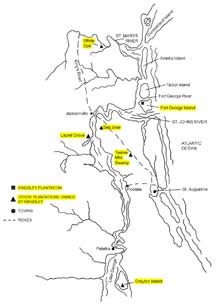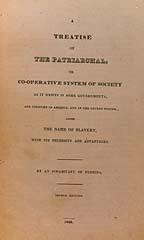
Zephaniah Kingsley arrived in St. Augustine, Spanish Florida, in 1803. As a new settler desiring land grants, he took the Oath of Allegiance to Spain. Kingsley began acquiring land, by land grant and purchase, settling first at Laurel Grove Plantation on Doctor’s Lake (in present-day Orange Park). His thriving mercantile and plantation operations were interrupted by the Patriots’ Rebellion in 1812, when invading U.S. troops occupied the well-provisioned Laurel Grove. Seminole Indians, hostile to the Americans, attacked the base and crops and property were destroyed. Forty-one of Kingsley’s slaves were killed or carried off by the Seminoles. Kingsley then moved to Fort George Island, renting a plantation from John Houston McIntosh until 1817, when he purchased the property for $7,000. The Fort George plantation was home to Kingsley, his African wife Anna Madgigaine Jai (whom he had purchased as a slave), and their four children until the 1830’s. During the time he lived at Fort George, Kingsley continued to increase his holdings. From the White Oak plantations on the St. Mary’s River to orange groves on Drayton Island in Lake George, Zephaniah Kingsley eventually owned over 32,000 acres of east Florida. Return to History of Kingsley Plantation. 
Territorial Change in FloridaWhen Florida became a United States territory in 1821, Zephaniah Kingsley was an influential, wealthy planter. He was considered “a classical scholar” by one of his peers, Congressional delegate Joseph M. White. In 1823, Kingsley was appointed to the second Florida Legislative Council by the local representative for President Monroe. In a speech to the Legislature, Kingsley addressed a subject of concern to the lawmakers: the black population of Florida—both slave and free. Although Kingsley advocated fair treatment of black freemen for the purpose of enlisting their support in controlling slaves, the majority of Southern slave owners feared free blacks. The prevailing attitude of Florida legislators was to aggressively enforce severely restrictive laws pertaining to the freemen. A planter who defended, and profited by, the institution of slavery, Kingsley wrote and published, in 1829, his opinions on a “patriarchal” system of slavery and furthered his arguments for “liberal provisions” for free blacks. In the Treatise, Kingsley used one of his plantations as an example and presented an idealized picture of slave life. Move to HaitiKingsley’s views were not shared by all planters, and circumstances for Florida’s black freemen worsened. In the late 1830’s, he relocated his wife and sons to Haiti. Kingsley had traveled and lived in Haiti before coming to Florida and described the country as “nearer to pure republicanism than any other”. There he set up a plantation for his family. Labor was provided by a number of his Florida slaves, who were freed and contracted to work under indenture. The Fort George plantation was sold to his nephew Kingsley Beatty Gibbs in 1839. Kingsley continued to own property and slaves in Florida and did not live permanently in Haiti. He was in New York when he died on September 30, 1843. Perhaps as much as any of his writings, his will relates the philosophy of Zephaniah Kingsley. |
Last updated: August 21, 2023
